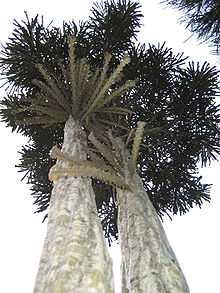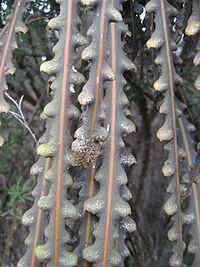Pseudopanax ferox
| Toothed Lancewood | |
|---|---|
 | |
| Adult tree with a few remnant juvenile leaves | |
| Conservation status | |
| Scientific classification | |
| Kingdom: | Plantae |
| (unranked): | Angiosperms |
| (unranked): | Eudicots |
| (unranked): | Asterids |
| Order: | Apiales |
| Family: | Araliaceae |
| Genus: | Pseudopanax |
| Species: | P. ferox |
| Binomial name | |
| Pseudopanax ferox | |


Toothed lancewood or horoeka, (Pseudopanax ferox), is a small tree endemic to New Zealand. It is similar to the more common Lancewood Pseudopanax crassifolius but with more prominently tooth-shaped leaves. The juvenile leaves are a very dark grey-brown to grey-green colour, narrow, stiff and up to 40 cm long. Once the slow growing tree reaches maturity at 10 to 15 years, the leaf form becomes shorter, wider and dark green in colour. It is only in adulthood that the tree's shape changes from one central stem and downward growing leaves to a more typical tree shape with branches spreading to build a round head. A mature toothed lancewood can reach 6 metres height with a trunk of up to 25 cm in diameter. The mature trunk has distinctive longitudinal grooves which sometimes twist slightly.
The tree is sometimes also called fierce lancewood in reference to its fierce looking saw tooth shaped juvenile leaves.
Use
Toothed lancewood used to be rare in cultivation, but is now a favoured gardening plant in New Zealand. It gained wide popularity following its use in the gold-medal winning New Zealand exhibit at the 2004 Chelsea Flower Show in the UK. The distinctive leaves and juvenile shape lend themselves to use in narrow spaces and are often used to complement modern building architecture. Due to its slow growth and relatively small size for a tree - even once mature - it is one of few trees suitable for small gardens.
Planting
Planting is best done in free draining soil in any semi-shaded to sunny position. Leaves are more numerous in sunny situations, which is noticeable on young specimens. Toothed lancewood is generally hardy and can withstand some minor frost damage to the tip (which may cause it to branch). It is also tolerant of dry locations and high winds.
References
- New Zealand Plant Conservation Network, URL:Pseudopanax ferox. Accessed 2010-10-04.
